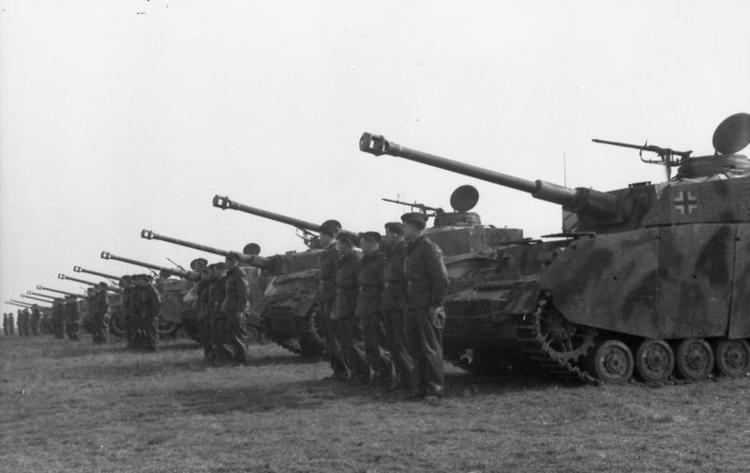 | ||
The term panzer division (German: Panzerdivision) as commonly used in English language refers almost exclusively to the armored (tank) division in the army branch of the Wehrmacht and of Nazi Germany during World War II. The panzer divisions were the key element of German success in the Blitzkrieg operations of the early years of the war. Later the Waffen-SS formed panzer divisions, and even the Luftwaffe fielded a panzer division, the Herman Goring Division. The term Panzerdivision is still used in today's Army of the Bundeswehr (for example 1. Panzerdivision). In German speaking countries the term is not immediately associated with the Wehrmacht as it is in English speaking nations, as the word simply means 'armored division' and has no additional connotation.
Contents
A panzer division was a combined arms formation, having both tanks (German Panzerkampfwagen, "armored fighting vehicle", usually shortened to "Panzer") and infantry as organic components, along with artillery, anti-aircraft, signals, etc. However, the proportions of the components of a panzer division changed over time.
Pre-war development
Heinz Guderian first proposed the formation of panzer units larger than a regiment, but the inspector of motorized troops, Otto von Stuelpnagel, rejected the proposal. After his replacement by Oswald Lutz, Guderian's mentor, the idea gained more support in the Wehrmacht, and after 1933 was also supported by Adolf Hitler. The first three panzer divisions were formed on 15 October 1935. The 1st Panzer Division was formed in Weimar and commanded by Maximilian von Weichs, the 2nd was formed in Würzburg and commanded by Guderian, and the 3rd was formed in Berlin and commanded by Ernst Feßmann.
Most other armies of the era organized their tanks into "tank brigades" that required additional organic and artillery support. Panzer divisions had their own organic infantry and artillery support. This led to a change in operational doctrine: instead of the tanks supporting operations by other arms, the tanks led operations, with other arms supporting them. Since the panzer divisions had the supporting arms included, they could operate independently from other units.
World War II
These first panzer divisions (1st through 5th) were composed of two tank regiments, one motorised infantry regiment of two battalions each, and supporting troops. Some of these panzer divisions had quite a large proportion of Panzerkampfwagen I in them, a tank that was never intended for combat. After the invasion of Poland in 1939, the old divisions were partially reorganised (adding a third battalion to some infantry regiments or alternatively adding a second regiment of two battalions). Around this time, the newly organised divisions (6th through 10th) diverged in organisation, each on average with one tank regiment, one separate tank battalion, one or two infantry regiments (three to four battalions per division).
By the start of Operation Barbarossa, the German invasion of the Soviet Union in 1941, the 21 panzer divisions had undergone further reorganisation to now consist of one tank regiment (of two or three battalions) and two motorised regiments (of two battalions each). Until the winter of 1941/42, the organic component of these divisions consisted of a motorised artillery regiment (of one heavy and two light battalions) and the following battalions: reconnaissance, motorcycle, anti-tank, pioneer, field replacement, and communications. The number of tanks in the 1941-style divisions was relatively small, compared to their predecessors' composition. All other units in these formations were fully motorised (trucks, half-tracks, specialized combat vehicles) to match the speed of the tanks.
During the winter 1941/42, the divisions underwent another reorganisation, composing each tank regiment of one to three battalions, depending on location (generally three for Army Group South, one for Army Group Centre, other commands usually two battalions). Throughout 1942, the reconnaissance battalions were merged into the motorcycle battalions.
By the summer of 1943, the Luftwaffe and Waffen-SS also had panzer divisions. A renewed standardization of the tank regiments was attempted. Each was now supposed to consist of two battalions, one Panzer IV and one Panzer V. In reality, the organization continued to vary from division to division. The first infantry battalion of the first infantry regiment of each panzer division was now supposed to be fully mechanised (mounted on armoured half-tracks (Sd.Kfz. 251). The first battalion of the artillery regiment replaced its former light-towed howitzers with a mix of heavy and light self-propelled guns (Hummel, Wespe). The anti-tank battalion now included both assault guns, tank destroyers, and towed anti-tank guns. Generally the mechanization of these divisions increased compared to their previous organization.
Since the Heer and the SS used their own ordinal systems, there were duplicate numbers (i.e. there was both a 9th Panzer Division and a 9th SS Panzer Division).
Heer:
Numbered
Named
Tank complement
The tank strength of panzer divisions varied throughout the war. The actual equipment of each division is difficult to determine due to battle losses, formation of new units, reinforcements and captured enemy equipment. The following table gives the tank strength of every division on two dates when this was known.
Flags
Panzer divisions used pink military flags.
